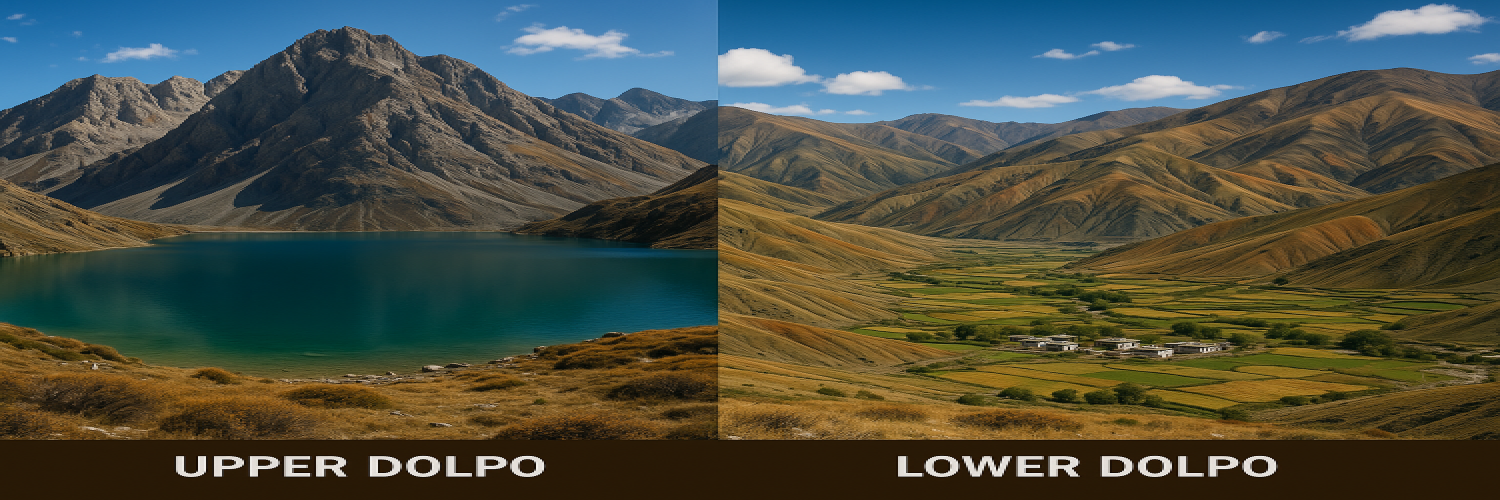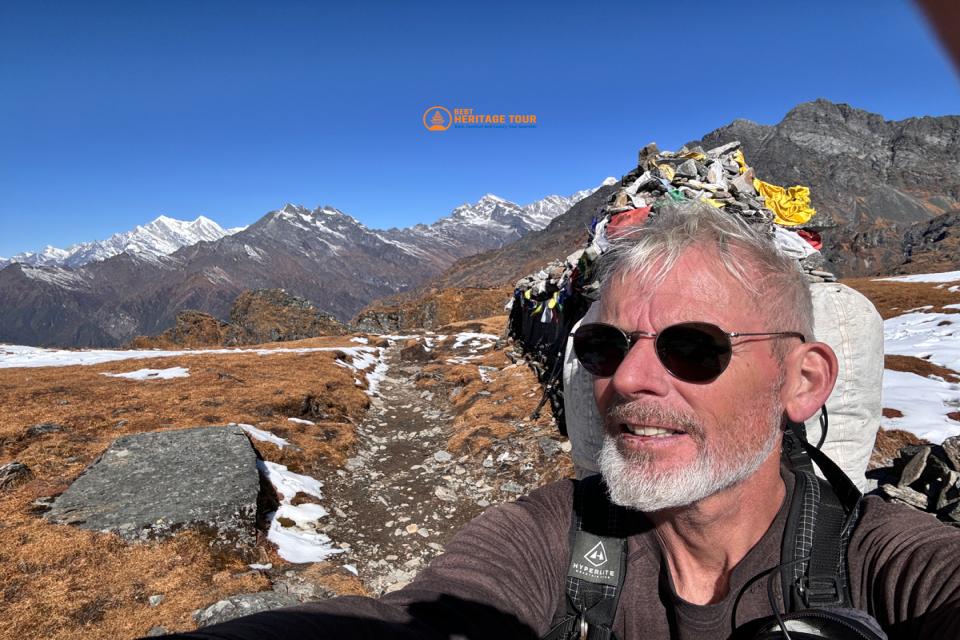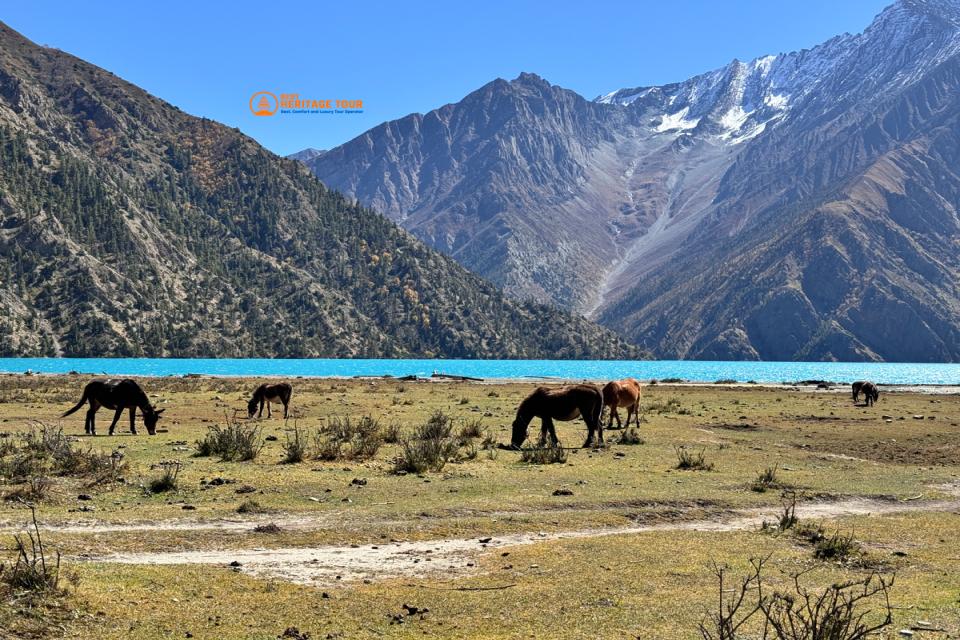The Dolpo region in Nepal is a secretive jewel nestled deep in the Himalayas, often described as a place where time stands still. For decades, this remote wilderness remained one of the most isolated parts of Nepal, preserving a unique cultural and natural heritage almost untouched by modern civilization. Today, trekking through Dolpo represents the ultimate Himalayan adventure, a rare opportunity to explore breathtaking landscapes, ancient Buddhist monasteries, and communities whose traditions have remained unchanged for centuries.
If you are considering a trek to Dolpo in 2025 or 2026, you will likely find yourself choosing between two incredible options: the Upper Dolpo Trek or the Lower Dolpo Trek. Each offers a distinct experience shaped by geography, culture, and trekking challenges. This blog aims to guide you through a detailed comparison of these two treks, helping you make a confident, well-informed decision.
Overview of the Dolpo Region
Dolpo is a vast Himalayan region located in the northwestern part of Nepal, bordering Tibet (China) to the north and west. It covers an area of approximately 7,889 square kilometers, making it one of the largest conservation areas in Nepal- the Shey Phoksundo National Park. Its rugged terrain varies from high arid plateaus to lush river valleys, and the climate swings from alpine cold to temperate zones depending on altitude.
Historically, Dolpo was a kingdom of its own until Nepal annexed it in the 18th century. Its geographic isolation, surrounded by towering mountain ranges and deep gorges, limited access by road or air, meaning its inhabitants maintained Tibetan cultural and religious traditions intact for centuries.
Dolpo is often divided into two trekking zones for logistical and geographical reasons:
-
Upper Dolpo: This area is characterized by some of the highest and most challenging terrain in Nepal. The villages are perched on remote highlands, with harsh weather and limited accessibility. Upper Dolpo is known for sacred lakes, vast highland plateaus, and ancient Buddhist sites.
-
Lower Dolpo: Positioned at lower altitudes, this region is more fertile, with greener valleys, farmlands, and more accessible trails. The culture here reflects a mix of Tibetan Buddhism and the indigenous Bon tradition, offering a rich tapestry of spiritual and daily life.
Understanding the contrasts between these two regions is key to choosing the right trek that matches your interests, physical readiness, and time availability.
Upper Dolpo Trek: Highlights and What to Expect
-
Route Overview and Duration
The Upper Dolpo Trek typically spans 25 to 30 days, starting from the remote airstrip of Juphal or the small town of Dunai, depending on your entry route. The trail winds through rugged landscapes, crossing multiple high mountain passes including the infamous Kanji La Pass, one of the highest in Nepal at over 5,100 meters.
Key stops include Ringmo village, home to the stunning Phoksundo Lake- Nepal’s deepest and most spectacular glacial lake and Shey Gompa, an ancient monastery established in the 11th century. Trekkers also pass through villages like Shimen and Saldang, where centuries-old Tibetan culture thrives.
This trek demands physical endurance and mental resilience, as many days involve steep ascents and descents, often in cold and windy conditions.
-
Cultural Immersion in Upper Dolpo
Upper Dolpo’s cultural richness is unrivaled. The inhabitants, mostly ethnic Tibetan, practice ancient Vajrayana Buddhism mixed with shamanistic Bon traditions. Visiting monasteries like Shey Gompa or Yungdrung Gumba offers rare insight into Buddhist rituals and festivals that are unique to this region.
The isolation of Upper Dolpo has preserved not only its spiritual practices but also ancient art, traditional dress, and customs. Many villages here have remained unchanged for centuries, providing trekkers with an authentic cultural immersion rarely found elsewhere.
-
Terrain, Altitude, and Physical Challenges
Trekking through Upper Dolpo means traversing an extreme high-altitude environment. The landscape is dominated by barren plateaus, steep cliffs, and glacial rivers. The highest passes exceed 5,000 meters, so altitude sickness is a real risk and must be carefully managed.
The trail can be rough, often crossing rocky paths and requiring sure-footedness. The weather can be unpredictable, with sudden snowstorms even in the best seasons.
Physical preparation is crucial. Trekkers must be in excellent shape, have prior high-altitude trekking experience, and be willing to take their time acclimatizing.
-
Wildlife and Natural Beauty
Upper Dolpo is part of Shey Phoksundo National Park, a protected area famous for its biodiversity. Trekkers may spot elusive Himalayan blue sheep, musk deer, snow leopards (rare), and the red panda in the forests.
Phoksundo Lake itself is a natural marvel, its crystal-clear turquoise waters contrast strikingly against the stark mountains. The vast alpine meadows are often dotted with wildflowers in spring and summer, creating surreal landscapes perfect for photography and reflection.
-
Best Time to Trek Upper Dolpo
The trekking seasons in Upper Dolpo are narrow due to the harsh climate. Late spring (April to June) and autumn (September to November) provide the most stable weather, with clearer skies and milder temperatures. Winter trekking is not recommended due to extreme cold and heavy snowfall, while the monsoon season (July-August) brings heavy rains and difficult trail conditions.
-
Permits and Regulations
Upper Dolpo lies within a restricted area, and trekkers must obtain special permits including a Dolpo Restricted Area Permit and a National Park Permit. These are more expensive and strictly regulated compared to standard trekking permits. Booking through a reputable agency like Best Heritage Tour is highly advisable to ensure all permits are handled properly.
Lower Dolpo Trek: Highlights and What to Expect
-
Route Overview and Duration
The Lower Dolpo Trek generally takes 15 to 20 days, making it more accessible to trekkers with limited time. The journey begins in Dunai or the village of Dho Tarap and moves through a series of fertile valleys, terraced fields, and traditional villages.
Lower Dolpo’s trail is less taxing physically compared to Upper Dolpo, but it offers equally compelling cultural and natural experiences. Key highlights include the villages of Dho and Nangkhong, the Chharka Gompa monastery, and the lush alpine meadows near the Mugu and Rara Lakes.
-
Cultural Experiences in Lower Dolpo
Lower Dolpo presents a fascinating blend of Tibetan Buddhist and Bon cultures. The people here practice rituals and festivals that reflect both religious traditions, resulting in vibrant cultural events filled with music, dance, and spiritual ceremonies.
The villages have a more agrarian lifestyle, with residents engaging in farming, herding, and traditional crafts like weaving and wood carving. Visitors can witness the craftsmanship firsthand and interact closely with the welcoming locals.
-
Terrain and Altitude
Unlike Upper Dolpo’s harsh high-altitude environment, Lower Dolpo’s trekking routes typically lie between 2,500 to 4,000 meters, reducing the risk of altitude sickness for most trekkers. The terrain includes river valleys lined with pine and rhododendron forests, rolling hills, and alpine meadows.
This moderate altitude and gentler terrain make Lower Dolpo suitable for trekkers of varying fitness levels who still want an authentic cultural and natural experience.
-
Flora, Fauna, and Scenic Beauty
Lower Dolpo’s diverse ecology ranges from temperate forests to alpine meadows. Rhododendrons bloom spectacularly in spring, creating a riot of color along the trails. The area is home to musk deer, Himalayan thar, and a variety of bird species, including the elusive Himalayan monal pheasant.
Scenic views include panoramic vistas of the Dhaulagiri and Kanjiroba mountain ranges, reflecting Dolpo’s rugged grandeur while providing a softer, greener backdrop than Upper Dolpo.
-
Best Time to Trek Lower Dolpo
Similar to Upper Dolpo, the optimal trekking seasons in Lower Dolpo are spring (April to June) and autumn (September to November). These months provide stable weather, ideal temperatures, and vibrant natural beauty.
-
Permits and Regulations
Lower Dolpo also requires a Restricted Area Permit, though it tends to be easier to obtain and slightly cheaper than Upper Dolpo permits. The region is less regulated but still requires trekkers to respect local customs and environmental guidelines.
Upper Dolpo vs Lower Dolpo: Comparative Analysis
Aspect |
Upper Dolpo Trek |
Lower Dolpo Trek |
|---|---|---|
|
Difficulty |
Very challenging- high passes, extreme altitude |
Moderate- lower passes, manageable altitude |
|
Altitude Range |
3,000m to 5,100m+ |
2,500m to 4,000m |
|
Cultural Immersion |
Intense Tibetan Buddhist traditions, remote monasteries |
Rich Tibetan-Bon culture, active village life |
|
Scenic Diversity |
High-altitude lakes, barren plateaus, glaciers |
Forests, alpine meadows, river valleys |
|
Accessibility |
Remote, long approaches, limited infrastructure |
More accessible, better trail infrastructure |
|
Cost |
Higher permits, longer trip, logistics more complex |
Lower cost, shorter duration, easier logistics |
|
Safety |
Risk of altitude sickness, rough terrain |
Safer due to moderate altitude and terrain |
Which Trek Should You Choose?
Choosing between Upper Dolpo vs Lower Dolpo ultimately depends on several personal factors:
Experience Level
-
If you are a seasoned trekker with strong endurance and experience at high altitudes, Upper Dolpo Trek will challenge and reward you with unparalleled wilderness and culture.
-
If you prefer a less strenuous yet culturally rich trek, Lower Dolpo Trek is ideal for moderate fitness levels.
Interests
-
For those fascinated by ancient Tibetan Buddhism, isolated monasteries, and rugged landscapes, Upper Dolpo provides a deeper spiritual journey.
-
If immersive cultural interaction with local villagers, witnessing traditional festivals, and enjoying greener landscapes appeal to you, Lower Dolpo is the perfect choice.
Time and Budget
-
Upper Dolpo usually requires 3-4 weeks and a higher budget for permits, guides, and logistics.
-
Lower Dolpo is more flexible with a 2-3 week itinerary and moderate costs.
Practical Tips for Trekking in Dolpo
-
Physical Preparation: Start endurance training months in advance, focusing on cardiovascular fitness and hiking with weight.
-
Gear: Layered clothing for temperature changes, waterproof jackets, durable trekking boots, sun protection, and a quality sleeping bag rated for sub-zero temperatures.
-
Health: Carry medications for altitude sickness and practice slow acclimatization. Stay hydrated and eat energy-rich foods.
-
Guides and Porters: Employ certified local guides to navigate difficult terrain, communicate with locals, and ensure safety. Porters help carry heavy loads, easing your journey.
-
Permits: Work with a reputable trekking company like Best Heritage Tour to secure all required permits and organize logistics smoothly.
Conclusion
Both the Upper Dolpo Trek and Lower Dolpo Trek offer unique, life-changing experiences for trekkers and cultural explorers alike. Your choice depends on your appetite for adventure, cultural interests, physical fitness, and available time.
Upper Dolpo challenges you with its high passes, sacred lakes, and ancient Tibetan Buddhist monasteries, a truly remote wilderness trek for experienced adventurers. Lower Dolpo, with its gentler trails, rich village life, and spiritual festivals, offers a more accessible yet equally captivating Himalayan journey.
Ready to Embark on Your Dolpo Adventure?
Whether you choose the rugged and spiritual Upper Dolpo Trek or the culturally rich and accessible Lower Dolpo Trek, Best Heritage Tour is here to make your journey seamless and unforgettable. From securing all necessary permits to arranging expert guides, accommodations, and logistics, we handle every detail with care and professionalism.
Don’t miss the chance to explore one of Nepal’s most enchanting and untouched regions in 2025/2026. Contact Best Heritage Tour today to customize your Dolpo trekking experience and start planning your once-in-a-lifetime Himalayan adventure!
Get in touch now and take the first step towards discovering the mystical beauty of Dolpo!
Email: info@bestheritagetour.com
Phone: +977-9851149197
Website: www.bestheritagetour.com
Office Address: Thamel, Kathmandu, Nepal
Author: Best Heritage Tour
Date: 30th May, 2025



